Day 10
Osorno and Puerto Varas...
|
|
Osorno is the capital of Osorno Province in the Los Lagos Region. In 1558, the city was founded by the governor, Garcia Hurtado de Mendoza, with the name of Villa de San Mateo de Osorno, in honor of his grandfather, Count of Osorno. Osorno sits in sight of Volcano Osorno, an active but minor volcano. The city's most prominent geographical feature is the Rahue River that runs North-South through its center. Located near the river front on the east side is the city's heart, the Plaza de Armas, a large, one-block park with fountains, benches, and tree-lined avenues. On the park's east side is the Catedral of Saint Matthew, one of the city's major landmarks, notable for its modern architecture.
|
|
On
the way to Puerto Varas we were to visit a cattle ranch, but the
owner had had a stroke and was in the hospital in Santiago.
|
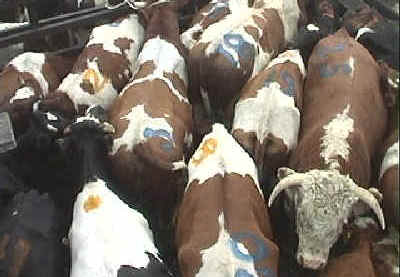 |
We
stopped at a cattle auction barn in Osorno instead. At the auction
barn they were unloading cattle and getting ready for the auction
while we walked over the catwalk to view the action. The cowboys
wore heavy wooden stirrups to protect their feet. They also do not
have saddle horns since they don't use ropes. Instead the horses
are trained to handle the cattle by using their bodies to move the
cattle along. |
|
We stopped in Osorno
to walk around the plaza and use the restroom at a café where
Terry knew the owners. Jim and I went to the post office to get
stamps, walked through the plaza and viewed the beautiful new church
with a modern steeple and bell tower. Osorno was a town in central
valley where all the ranchers came to do their business. It was busy
the day we were there. |
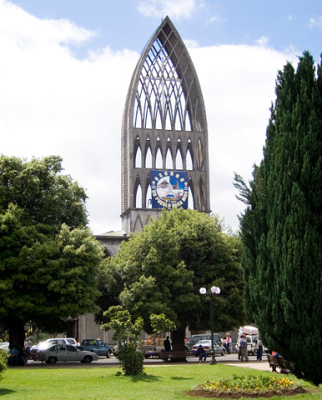 |
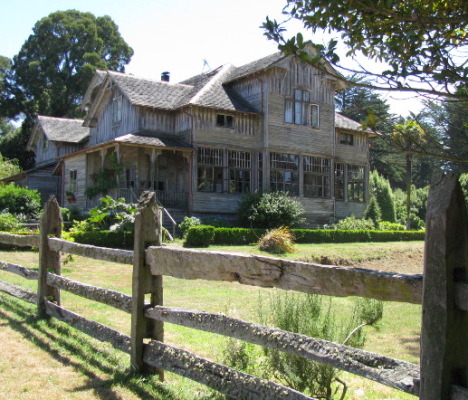 |
|
As our journey
continued we drove through beautiful lake country to the home of a
German/Swiss woman and her daughter. The road was gravel and Terry
wasn't quite sure which home to go to. We were truly amazed when
we got there. The home was huge and built in the early 1900's. It
looked run down, but just had a weathered look. Inside it was
beautiful and full of good old German smells.
|
|
We had lunch under a
tent in the backyard. We had Pisco Sours again and a wonderful lunch
with salmon mousse, steak and a yummy dessert and, of course, wine.
Most of us toured the house and Jim and Jim walked around the farm
over looking the lake.
The woman's father
and grandfather had the farm. She married and had recently divorced
her husband. She rented the land out and turned the home into a B &
B for people coming from Santiago on vacations. |
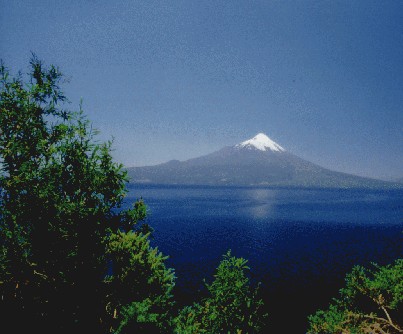 |
|
Her daughter had
been studying about the tourist industry in Switzerland and was home
to help her mom. They were going to spend the winter in Switzerland.
Terry knew the family as her youngest son had gone to school with
the daughter. It was truly a delight to spend time with them and to
enjoy the beautiful scenery. |
|
After we left the B&B
we drove to Puerto Varas and arrived rather late in the day. The
city was busy and right on a huge lake, Lago Llanquihue. |
|
Puerto Varas is a city located in the southern Chilean province of Llanquihue, in the Los Lagos Region. The city is well known for its German traditions, its food, its seafood, the scenery and its casino.
Located on the shore of the Lake Llanquihue, one of the largest natural lakes in South America. The perfect cone of Osorno volcano and the snowcapped peaks of Mt. Calbuco and Mt. Tronador are clearly visible from the lakefront.
The city, known as "the city of roses", was founded in 1854 by Vicente Perez Rosales. The city is named after Antonio Varas, minister of the interior during the presidency of Manuel Montt, when the city was founded.
|
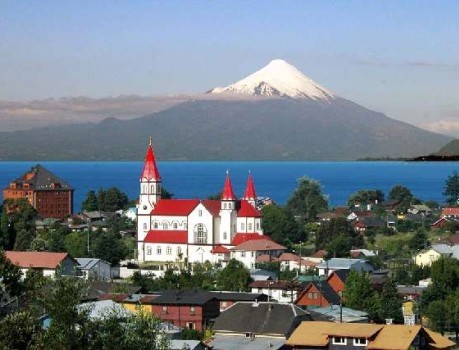 |
Unfortunately our hotel, Hotel Bordelago, was about 3 or 5 miles
outside of the city and there wasn't anything to do. The hotel was
new and partly under construction and although clean it was not what
we had been used to. There were a lot of complaints. A few of our
group took a taxi into town and went to the Casino for the evening.
We did have a wonderful view of the lake and two inactive volcanoes
outside our window. |
Day 11
Vincent Perez Rosales National Park...
Vicente Perez Rosales National Park is located in Los Lagos Region, Llanquihue Province, of Chile. This national park covers about 2,530 kms2 and is almost entirely in the Andes mountain chain. |
|
The adjacent Vicente Perez Rosales and Puyehue National Parks in Chile; and the Nahuel Huapi and Lanin National Parks in Argentina, provide a continuous protected area of close to 15,000 kms2.
The park protects the body of Todos los Santos Lake. The outlet of the lake gives rise to the Petrohue River, which flows through the Petrohue Waterfalls. The Park also contains the eastern slope of Volcan Osorno. |
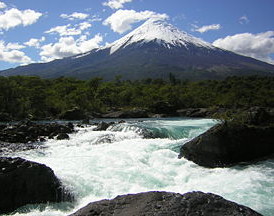 |
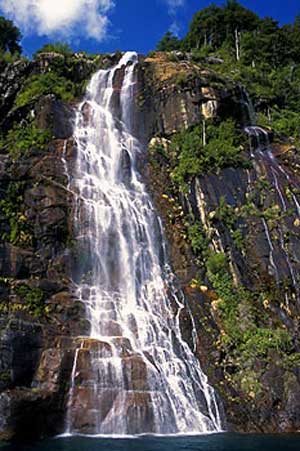 |
This area of Chile is
known as "Switzerland of South America" and was it beautiful.
We headed out for the park and stopped at a waterfall along the way.
It was beautiful with crystal blue water and a view of Osorno
volcano. The walk was about a quarter mile back to the falls, but
the path was cleared and there were clean restrooms. The water was
from Lago Todos Los Santos and wound around the mountains and out to
the sea. There were a lot of tour buses there from cruise ships near
by. At a tourist stand, I purchased several alpaca scarves to bring
home.
We drove on through
the park to Petrohue, which is a resort near the lake. We had lunch
there in the hotel and it was wonderful again. We had salad, salmon,
and a yummy pudding like dessert. We had water instead of wine for
lunch. In Chile they try to serve water "sin gas", meaning
carbonated water. We all wanted regular water instead. |
|
After lunch we got on
small boats and toured around the lake. This and connecting
lakes is a way to get to Argentina. It's a long way as
they cross the Andes and have to get on a bus, then on a boat
again. It takes all day.
Our boat tour was
about an hour. We passed Mt. Osorno and it was beautiful. Over half
of the group went on a hiking tour and were picked up at another
location on the lake. It was fun to watch people being transferred
from one boat to another. |
 |
 |
Jim went on the hike and I went back to
the dock and shopped for jewelry at a small stand. Then I stayed
down by the water and waited for the other boat to come back. They
were gone about two hours and Jim said the walk was up and down and
somewhat strenuous. |
|
By the time the two
groups got all together, the crowds at Petrohue had really grown and
it was hard for the buses to get around. It was a Saturday and many
people came out for the day. Plus the day was beautiful, sunny and
warm.
On our way back to
Puerto Varas, we stopped at a dairy farm and had high tea. This was
one of the local farms that had been given to German or Swiss
immigrants many years ago. |
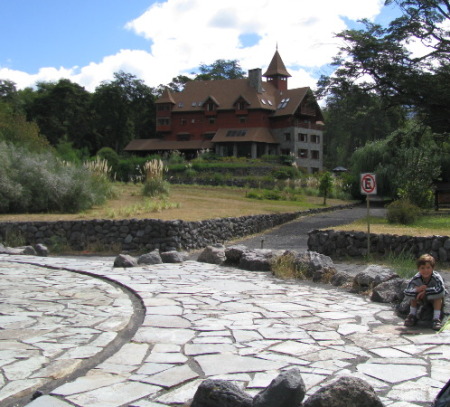 |
|
Most people think that the German population in Chile arrived during the last century; however, the Chilean government in 1845 started a program of attracting foreigners to Chile's southern lake district. Many of these German communities work small dairy farms.
|
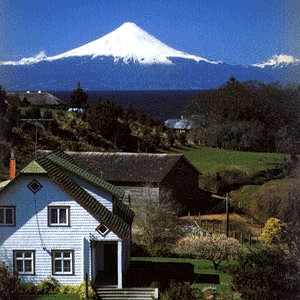 |
The land was a narrow strip and ran back
from the lake about 6 kilometers. In the early days, the only
access to the outside world was by water. It took a lot of work to
clear the land and make it as beautiful as it is today. Naturally,
being German or Swiss the land was clean and neatly kept.
The farm was unique
and in order to continue to make a profit, the owners have turned it
into a family gathering and entertainment place for children in the
lake country. Many people stop on their way back from a day at the
park. |
|
There was a zip line for children as well as many animals.
Parents can sit and watch the scenery while the kids run around and
have a good time. |
|
The tea was something
else. We had dessert first, with coffee, tea, or hot chocolate.
Then we had fresh baked bread with butter, salmon spread, jelly, a
relish, sausage, and other things. It was lovely there with
mountains and lakes all around. None of us wanted to leave to go
back to the hotel which we didn't like. It was also windy and
cool. When we got back to
the hotel, Jim and I walked down a steep path to the lake. It was
very calm and the view was beautiful. There was a line of smoke
across the lake and it looked like smoke from a volcano. |
 |
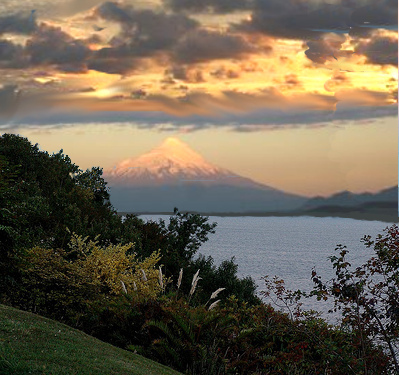 |
We thought
we would tease everyone and say it was an active volcano. It wasn't.
Though it was just smoke, it made for a good picture.
Back in the room the
two volcanoes were beautiful with the setting sun shining on them.
This was our last
night as a whole group. Sixteen of the 35 were headed back to the
U.S. in the morning, while the rest of us were flying on down to
Punta Arenas in Patagonia. |
|
Terry Reagan left us
and headed back with those returning to Santiago. She was a
wonderful tour guide and knew a lot about Chile. She is a U.S.
citizen and had married a Chilean she met in college in California.
They moved to Chile and after two children divorced. She later
married a Chilean farmer and had one son. Two years ago her husband
was killed in a farm accident. She has been a tour guide since and
makes her home on Easter Island. She knows a lot of people and
places, and makes sure her clients have the best of the best on tour
while in Chile. |
PATAGONIA: Day 12
Patagonia is a geographic region containing the southernmost portion of South America. Mostly located in Argentina and partly in Chile, it comprises the Andes mountains to the west and south, and plateau and low plains to the east.
The Chilean portion embraces the southern part of the region of Los Lagos, and the regions of Aisen and Magallanes. It excludes those portions of Antarctica claimed by both Chile and Argentina.
The name Patagonia comes from the word patagon used by Magellan to describe the native people who his expedition thought to be giants. It is now believed the Patagons were actually Tehuelches with an average height of 5'11" compared to the 5'1" average for Spaniards of the time.
Puerto Montt and Punta Arenas... |
|
Puerto Montt is a port city in southern Chile, located at the northern end of the Reloncavi Sound in the Llanquihue Province. The city's economy is based upon agriculture, forestry, fishing and salmon aquaculture in the surrounding islands and fjords. It is the fastest-growing city in southern Chile and has one airport, El Tepual, where three airlines have regular flights.
On this day, 19 of us
left Puerto Montt and flew to Punta Arenas. |
 |
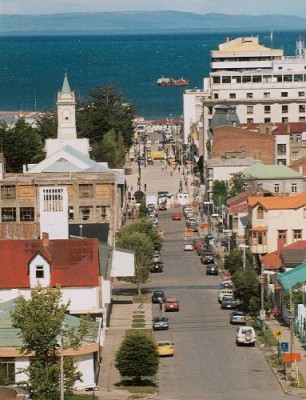 |
The rest of the group,
and Terry, headed back to Santiago and on to the US. We had a
two-hour flight delay because of fog in Puerto Montt. Our flight was
about 2 hours and it was raining in Punta Arenas when we arrived. We
drove through Punta Arenas and on to our hotel and got our rooms.
The hotel was an old building converted into a beautiful hotel in the
heart of the city. Our room was large with a sitting area and a
homey look, and over looked the river that ran through town. We had
time to go out for lunch with Jim and Ruth Goldman and went to a
local pizza café. We had a fun trying to communicate with the
waiter while ordering our pizza. The other patrons in the café
laughed at us as we tried to order in our broken Spanish. |
|
Punta Arenas, meaning Sandy Point, is the most prominent settlement on the Strait of Magellan and the capital of the Magallanes y la Antartica Chilena Region. The city, located on the Brunswick Peninsula, is the southernmost city of its size in the world. It is roughly 880 miles from the coast of Antarctica. |
|
Our new guide in Punta
Arenas and Patagonia was RosaMaria, a 27 year old whose family owned
a sheep ranch on Tierra Del Fuego. She had been leading tours, but
on a limited basis, and her English was pretty good; however, she
still had some problems with certain words. We had a smaller bus and
the driver had to take some of the back seats out to fit all our
luggage. |
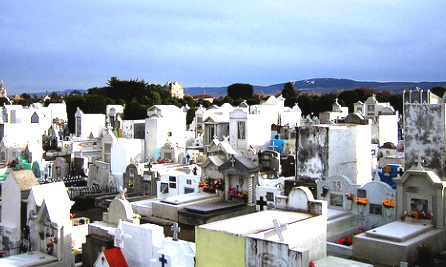 |
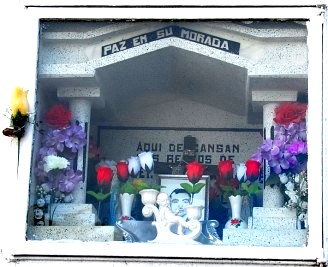 |
|
We left the hotel
about 3:00pm and went on a tour of the city. The clouds broke up and
the sky was a beautiful deep blue. It was in the 50's and some
breeze, but comfortable. Rosa insisted we go to the cemetery, which
none of us were too interested in, but we went anyway. The huge cemetery
is a main attraction in the area and it is beautiful. Sculpted
evergreens line the walkways around the mausoleums. I think Rosa wanted to go there to show us her family's
tomb. It is a custom in Chile for relatives to visit their
ancestors' graves on a regular basis and to keep them decorated.
|
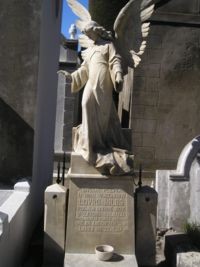 |
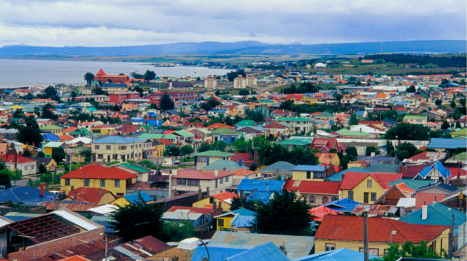
After the cemetery we
went up on the hill and saw the whole city and the Straits of
Magellan. The roofs of the houses are all different colors and it
was beautiful against the blue sky and the blue ocean. We could see
Tierra Del Fuego in the distance. |
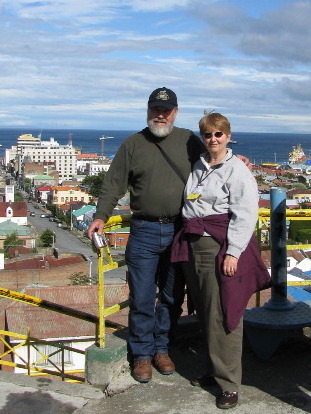 |
|
|
Rosa asked us if we
wanted to go to museums or go to a horse-breaking event. None of us
wanted to go to museums, so we drove out of Punta Arenas about half
and hour to a horse arena. There were a lot of people standing
around the arena watching the gauchos, dressed in their traditional
attire, having a horse breaking contest. They would tie up an
unbroken horse, saddle him, and a gaucho got on and tried to stay on
as long as possible. |
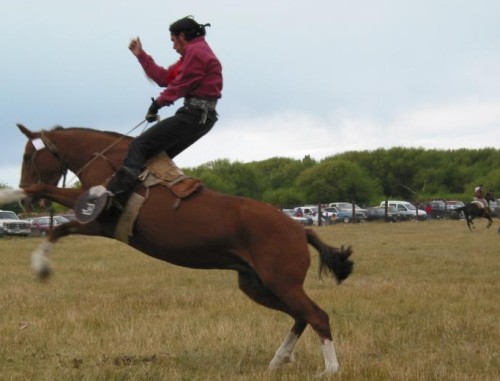 |
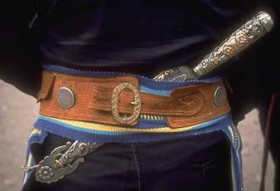
It was fun and the crowd whopped and yelled for their favorite riders. It was a real event with barbeque and other
things, though some had a bit too much vino. |
|
We left and went back
to the hotel for a wonderful crab and salmon dinner, and a Pisco Sour
and plenty of wine. The restaurant was at the top of the hotel with
windows giving us a wonderful view of the city and the Straits. Very
full, we went to bed and slept well. |





















